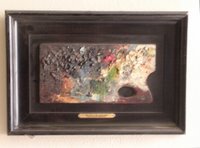Peggy and the Ziggurat
Peggy Sanders, who has a drawing in the P&C's Lavoratory Gallery,
went to Iraq in 1982 as an artist in an archeological expedition from the University of Chicago.
One of her paintings from that trip is shown above and is currently on exhibit at the Oriental Institute until September 2.
Here's what she wrote about it in the catalog:
This painting is based on a black-and-white photograph from my first season with the University of Chicago Expedition to Nippur, Iraq. Our small party is traversing the site, which has been buried for most of the past century by slowly migrating dunes of sand. The ziggurat, once the religious center of ancient Mesopotamia, is our destination. its ancient form has been softened by erosion; the baked brick house on top, where the temple once stood, is a “modern” construction.
As we trudge along the crest of the dunes, we are crossing the ancient Euphrates riverbeds. ironically, the dunes depicted in the painting strongly suggest ocean waves, except that these waves of sand are much more firm than water.
Initially, one’s perception is that the dunes are stationary. But over the years one can discern their movement, drifting eastward. This almost imperceptible change is a continuation of the evolution of the site from its days as a living city to its abandonment and physical deterioration, and its gradual burial. The ziggurat, of course, remains exposed — it is the tallest structure in the entire region and the focal point of the painting.
For me, this painting is about journey. It is a depiction of an archaeological site, but it also reflects our evolution through time, our walk through life. it reflects the adventure of exploring the site and appreciating the intriguing beauty of a deserted place. It is also about one’s inner journey. You, the viewer, have become a member of this expedition, following, journeying, and pondering the past, the future and the present.
The catalog, as well as the above booklet of picture cards, can be purchased at the museum gift shop.




